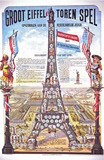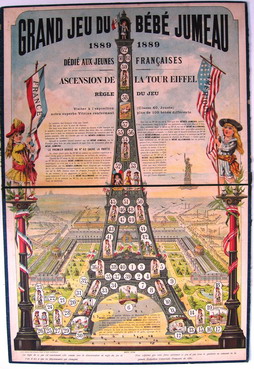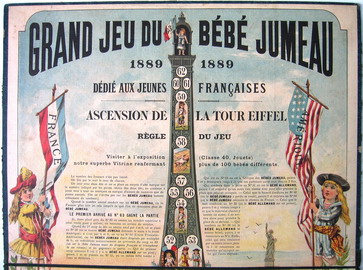Giochi dell'Oca e di percorso
(by Luigi Ciompi & Adrian Seville)
(by Luigi Ciompi & Adrian Seville)

|
Giochi dell'Oca e di percorso
(by Luigi Ciompi & Adrian Seville) |

|
 |

Torna alla ricerca giochi (back to game search) |
 |
| Grand Jeu du Bébé Jumeau | ||
| 1889 Dèdiè aux jeunes françaises. Ascension de la Tour Eiffel. Regle du jeu. | ||
 |
Versione stampabile
 |
Invia una segnalazione

|
    |
primo autore: | Non indicato |
| secondo autore: | Amand | |
| anno: | 1889 | |
| luogo: |
Francia-Parigi |
|
| periodo: | XIX secolo (4°/4) | |
| percorso: | Percorso di 63 caselle numerate | |
| materiale: | carta (paper) (papier) | |
| dimensioni: | 670X445 | |
| stampa: | Litografia a colori | |
| luogo acquisto: | Francia-Ferrieres en Gatinais | |
| data acquisto: | 06-03-2007 | |
| dimensioni confezione: | ||
| numero caselle: | 63 | |
| categoria: | Agricoltura, Industria, Commercio, Esposizioni, Arti e Mestieri | |
| tipo di gioco: | Gioco oca variante | |
| editore: | Lith. Amand, Amsterdam&Parigi, 27 Rue Guenegaud | |
| stampatore: | Lith. Amand, Amsterdam&Parigi, 27 Rue Guenegaud | |
| proprietario: | Collezione L. Ciompi - A. Seville | |
| autore delle foto: | L. Ciompi - A. Seville | |
| numero di catalogo: | 457 | |
| descrizione: |
Gioco di 63 caselle numerate. “Clou” dell’Esposizione Universale del 1889, la Torre Eiffel servì come modello a molti editori di giochi. Decoupages, giochi di costruzione e di percorso, rompicapo, furono numerosi dal 1889. Le “Grand jeu du Bebé Jumeau” dedicato ai giovani francesi, è un ricordo dell’Esposizione Universale ed una meravigliosa pubblicità per la firma Jumeau ma è allo stesso tempo un documento di propaganda nazionalista. La Torre Eiffel è il supporto per un percorso di 63 caselle. Quelle negative sono riservate alle bambole tedesche che cadono nel pozzo, soggiornano in prigione, si rompono alla casella 58 che rappresenta la morte. Le caselle delle oche sono occupate dalle bambole Jumeau: dietro il piano di gioco il Campo di Marte e l’Esposizione universale si uniscono in un orizzonte al di sopra del quale si innalza la Statua della Libertà. Ai due lati della Torre due colonne sostengono due bambini: un Bebé Jumeau che simboleggia la Francia e un fanciullo che rappresenta la “giovane America”. Le regole del gioco sono quelle conosciute del gioco dell’oca. In basso: “ Speriamo che voi attacchiate questo gioco su cartone e lo conserviate come ricordo della Grande Esposizione Universale di Parigi del 1889”. REGOLE: al centro. CASELLE: mute. REFERENZA 1 GROT EIFFEL TOREN SPEL. Versione olandese ( Riproduzione, Atlas van Stolk, Rotterdam 1974). Questo gioco di percorso che ha per tema l’Esposizione Universale del 1889 e in particolare la Torre Eiffel, presenta delle regole identiche al gioco dell’oca. Come si legge nel testo solo la fisionomia delle caselle e il loro nome cambiano tanto che le “bébés Jumeaux” piazzate di 9 in 9 rimpiazzano le oche e le caselle negative 6, 12, 31, 52, e 58 sono rappresentate da “bébés allemands”. La casella 19 rappresenta la fabbrica delle bambole “jumeaux” dove si sosta due turni e la casella 42 un “bébé jumeau” smarrito. Sembra che queste bambole di cui si parla, siano state commercializzate proprio in occasione dell’Esposizione Universale del 1889. E’interessante notare che questo gioco sembra indicare un avvicinamento fra la Francia e gli Stati Uniti proprio in occasione della manifestazione. Da notare in questa versione la comparsa di pubblicità: "Blooker's Cacao geeft de fijnste kop Chocolade". REFERENZA 2 GRAND JEU DU BÉBÉ JUMEAU dédié aux jeunes françaises – Ascension de la Tour Eiffel. Paris, Lith. Amand, 1889. 68 x 46 cm. Jeu de l’oie lithographique en couleurs publié à l’occasion de l’Exposition Universelle de 1889. Le plateau est une vue aérienne du Champ de Mars avec les pavillons de l’exposition, au fond la statue de la Liberté et au premier plan la Tour Eiffel sur laquelle sont disposées les 63 cases. La scène est encadrée de deux colonnes surmontées des deux jumelles portant chacune un étendard représentant la France et les États-Unis. (Oberlé, Gérard - Pimpaneau, Tristan) REFERENZA 3 Game 56: Game of the Baby Jumeau Dolls Grand Jeu du Bébé Jumeau. Paris/Amsterdam: Lith. Amand, 1889. Chromolithograph, 66 x 44 cm., laid onto two-panel folding board. Refs.: Ciompi/Seville 0457; Girard/Quétel, pl. 72. This game is altogether more complex than the Tramway game above. It is associated with the Paris Exposition Universelle Française held from 6th May to 31st October 1889, featuring the newly built Eiffel Tower. The unicursal track of 63 spaces is set out on a large image of the tower, proceeding in a complex way to the winning space at the top. The exhibition took place at a time of strong pro-American feeling in Paris, as indicated by the two flags at the top of the sheet and by New York’s Statue of Liberty in the background. Its framework was also engineered by Eiffel, and a bronze replica of the statue was installed in Paris on July 4, 1889 near the Grenelle Bridge. The game sheet, lithographed in color by the Amsterdam and Paris firm of Amand, is of large format and bears the statement in French: “We hope that you will put this game onto cardboard and that you will keep it as a souvenir of the grande Exposition Universelle Française..” The sheet also gives details of the firm of Jumeau, manufacturers of upmarket dolls: ”The large and beautiful factory at Montreuil, where the Jumeau Dolls come from, was small at first but ... now covers 6000 square meters and employs 1000 staff....” The Jumeau dolls were of bisque, wonderfully dressed in the elaborate fashions of the period, but were very expensive and suffered from competition against cheap imported German dolls. This struggle against German competition is reflected quite unashamedly in the game. The favorable spaces, on the traditional Goose numbers, are denoted by images of the Jumeau dolls. The unfavorable (hazard) spaces are also treated thematically. Most dramatic of these is the death space, on 58, where there is a broken German doll; the prison space, at 52, incarcerates another one, weeping piteously; and it is again a German doll who finds herself in the well, at 31, waiting to be rescued, while yet another is found on the bridge space at number 6, where she must pay for passage. However, at the labyrinth, space 42, it is a Jumeau doll who loses her path and must return to space 30, where she rejoins the “French way.” The space at 19 (normally the inn) is represented by the Jumeau factory, while the favorable dice spaces at 26 and 53 both represent Franco-American unity. This game is conspicuous for its transparent attempt to influence the player towards the French product, while damning the German rival with ”knocking copy.” Though the firm is no more, the Jumeau dolls are much prized today by collectors and prices in five figures are realized for the rarer kinds. (Adrian Seville) Exhibitions: - "Le Jeu de l’Oie au Musée du Jouet". (Catalogo a cura di Jeanne Damamme - Pascal Pontremoli, pag. 13,99). Musée du Jouet, Ville de Poissy, 23 mars - 1.er octobre 2000. - "The Royal Game of the Goose four hundred years of printed Board Games". Exhibition at the Grolier Club, February 23 - May 14, 2016 (Prof. Adrian Seville). |
|
| bibliografia: |
1) Catalogo Mostra: “Le jeu de l’oie au musée du jouet”, Ville Poissy 2000. 2) SEVILLE, Adrian: "The Royal Game of the Goose four hundred years of printed Board Games". Catalogue of an Exhibition at the Grolier Club, February 23 - May 14, 2016. 3) SUMPF, Alexandre: "Le Grand jeu du Bébé jumeau", Histoire par l'image [en ligne)]. 4) SEVILLE, Adrian: "L'arte dei giochi da tavolo. Oltre un secolo di storia e divertimento dalla fine del Settecento all'inizio del Novecento." Edizioni White Star, 2019. |
|
| L’Exposition Universelle dans la Ville - Lumière (1889) | ||
Vai alla ricerca giochi Vai all'elenco autori